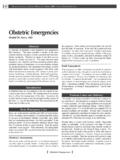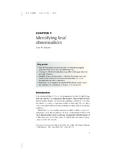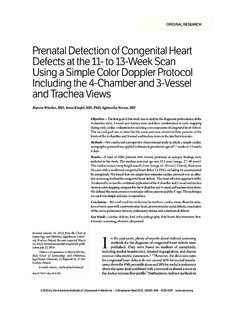Transcription of International Fetal and Newborn Growth - MedSciNet
1 September 2009 INTERGROWTH-21st International Fetal and Newborn Growth Standards for the 21st Century The International Fetal and Newborn Growth Consortium BASIC neonatal CARE MANUAL 2 Please read this manual carefully and refer to it throughout the study if any clarification is needed This Operations Manual was produced by the INTERGROWTH-21st neonatal Group, based on the 1st Meeting of the neonatal Group, Oxford, July 2009. This document reflects the consensus reached by members of the group regarding the definitions of neonatal morbidities and the minimum standards of care to be provided by all centres taking part in the INTERGROWTH-21st study. INTERGROWTH-21st is a large project involving health institutions from eight geographically diverse countries.
2 It is therefore essential that all participating institutions follow a standardized neonatal care protocol. 3 Table of Contents Credits .. 4 Abbreviations .. 5 Definitions of neonatal Morbidities .. 6 Transient Tachypnea of Newborn (TTN) .. 7 Respiratory Distress Syndrome (RDS) .. 7 Bronchopulmonary Dysplasia (BPD) .. 8 Meconium Aspiration Syndrome .. 8 Retinopathy of Prematurity (ROP) .. 8 Periventricular Leukomalacia .. 9 Apnea of Prematurity .. 9 Hypoxic Ischemic Encephalopathy (HIE) .. 10 Birth Asphyxia .. 10 Intraventricular Hemorrhage (IVH) .. 11 Necrotizing Enterocolitis (NEC) .. 12 Polycythemia .. 12 Anemia requiring transfusion .. 13 Acute Bilirubin Encephalopathy .. 14 Chronic Bilirubin Encephalopathy .. 14 Hypotension in Neonates .. 14 Hypoglycemia .. 14 Inborn Error of Metabolism .. 15 Treatment and Management Recommendations for neonatal Morbidities.
3 17 Administration of Antenatal Steroids to Women at Risk of Preterm Delivery .. 18 Feeding the Preterm Infant .. 19 Thermoregulation in Preterm Newborn Babies .. 21 Administration of Surfactant to Preterm Infants with or at Risk for RDS .. 25 Use of Nasal CPAP for Respiratory Distress Syndrome (RDS) .. 26 Screening for Intraventricular Hemorrhage (IVH) and Periventricular Leukomalacia (PVL) .. 27 Periventricular Leukomalacia (PVL) .. 28 Screening for Retinopathy of Prematurity (ROP) .. 29 Hypoxic Ischemic Encephalopathy (HIE) .. 34 neonatal Hyperbilirubinemia .. 39 Hypotension in Neonates .. 43 Patent Ductus Arteriosus (PDA) in Preterm Neonates: (<34 weeks gestation) .. 45 Sepsis .. 48 4 Credits This manual was prepared by members of the INTERGROWTH-21st neonatal Group and reflects the general consensus reached during the neonatal Group Meeting, Oxford, 6-7th July 2009, regarding the minimum standards of neonatal care to be provided by all INTERGROWTH-21st centres.
4 The following people made important contributions to this final version, for which we thank them: Zulfiqar Bhutta Group Leader (Husein Laljee Dewraj Professor and Chairman, Department of Paediatrics and Child Health, Aga Khan University Medical Centre, Karachi, Pakistan) Anila Haroon (Senior Instructor, Department of Pediatrics and Child Health, Aga Khan University Medical Centre, Karachi, Pakistan) Francesca Giuliani (Medical doctor, neonatal Unit, Department of Pediatrics of Turin University, Regina Margherita, S. Anna Hospital, Turin, Italy) Maneesh Batra (Assistant Professor of Pediatrics, Division of Neonatology, University of Washington School of Medicine, Seattle, USA) Enrico Bertino (Professor, neonatal Unit, Department of Pediatrics of Turin University, Regina Margherita, S. Anna Hospital, Turin, Italy) Vinod Paul (Professor, Division of Neonatology, All India Institute of Medical Sciences, New Delhi, India) Kenny McCormick (Consultant & Honorary Senior Lecturer, neonatal Unit, John Radcliffe Hospital, Oxford, UK) Elaine Albernaz (Pediatrician, Pediatric Intensive Care Unit, Univeridade Catolica de Pelotas, Pelotas, Brazil) Bashir Bhat (Neonatologist, Department of Pediatrics, SCBU, Khoula Hospital, Muscat, Oman) Roseline Ochieng (Program Director, Department of Pediatrics and Child Health, Aga Khan University Hospital, Nairobi, Kenya) Vikram Rajan (Director; neonatal Unit, Rajan Newborn Care Unit (P) Ltd; Honorary Asst.)
5 Professor Neonatology, Indra Gandhi Medical College, Nagpur, India) Pang Ruyan (Principal Investigator, Beijing Obstetrics and Gynaecology Hospital, Maternal and Child Health Center, Capital Medical University, Beijing, China) Hannah Knight (Research Associate, INTERGROWTH-21ST Project, Nuffield Department of Obstetrics and Gynaecology, University of Oxford, Oxford, UK) 5 Abbreviations LBW Low birth weight infants, defined as <2500g at birth VLBW Very low birth weight infants, defined as <1500g at birth ELBW Extremely low birth weight infants, defined as <1000g at birth 6 Definitions of neonatal Morbidities to be used for the INTERGROWTH-21st Study 7 Transient Tachypnea of Newborn (TTN) TTN is a parenchymal lung disorder characterized by pulmonary edema resulting from delayed resorption and clearance of Fetal alveolar fluid.
6 The onset of TTN is usually at the time of birth and within two hours after delivery with tachypnea being the most prominent clinical feature. Characteristic findings on chest radiograph support the diagnosis and include increased lung volumes, and prominent vascular markings, with fluid in the interlobar fissure. In order to make the diagnosis, other conditions (such as pneumonia, respiratory distress syndrome, pneumothorax, etc) must be ruled out. Symptoms of TTN usually last for 12 to 24 hours, but may persist as long as 72 hours in severe cases. Infants rarely require supplemental oxygen, but if required they usually respond to oxygen therapy. When oxygen is needed, usually concentrations less than 40 percent are sufficient to achieve adequate oxygenation.
7 REFERENCE Guglani, L et al. Transient Tachypnea of the Newborn . Pediatr. Rev. 2008; 29;e59-e65 Respiratory Distress Syndrome (RDS) An infant is determined to have respiratory distress syndrome if each of the following is true: Requires O2 at 6 hours of life continuing to age 24 hours Demonstrates clinical features within age 24 hours Has need for respiratory support to age 24 hours, AND Has an abnormal chest x-ray within age 24 hours consistent with surfactant deficiency OR Has received surfactant therapy within the first 24 hours of life REFERENCE Fanaroff AA, Stoll BJ, Wright LL, et al; NICHD neonatal Research Network. Trends in neonatal morbidity and mortality for very low birth weight infants. Am J Obstet Gynecol 2007; 196 8 Bronchopulmonary Dysplasia (BPD) BPD defined as 1) Chronic supplemental oxygen needs for >28 days (28 days oxygen need based BPD) OR 2) Chronic supplemental oxygen needs at either PMA of 36 weeks or discharge from hospital whichever come first (36 weeks Oxygen need based BPD) REFERENCE Pascal M.
8 Lavoie, Chandra Pham, Kerry L .Jang. Heritabilty of Bronchopulmonary Dysplasia, defined according to consensus statement of National Institute of ; 122:479-485. Meconium Aspiration Syndrome Meconium Aspiration Syndrome (MAS) is defined as respiratory distress in an infant born through meconium stained amniotic fluid (MSAF), whose symptoms cannot be otherwise explained. This disorder may be life threatening complicated by respiratory failure, pulmonary air leaks and persistent pulmonary hypertension. REFERENCE Fanaroff AA. Meconium aspiration syndrome: historical aspects. J ; 28:3-7 Retinopathy of Prematurity (ROP) ROP a developmental vascular retinopathy occurs only in the incompletely vascularized retina of premature infants, leading to a wide range of outcomes from normal vision to blindness.
9 For a diagnosis of ROP to be documented we need a confirmed diagnosis by an ophthalmologist in the notes according to the staging criteria below; Staging of ROP: Stage1: Demarcation line separating the avascular retina anteriorly from the vascularized retina posteriorly, with abnormal branching of small vessels immediately posterior. 9 Stage 2: Intraretinal ridge; the demarcation line has increased in volume, but proliferative tissue remains intraretinal. Stage 3: Ridge with extraretinal fibrovascular proliferation. Stage 4: Partial retinal detachment Stage 5: Total retinal detachment. REFERENCES International Committee for the classification of Retinopathy of Prematurity The International classification of Retinopathy of Prematurity Revisited Arch Ophtalmol 2005;123:991-999. , Adriann Coombs, Pamela Weber, Corina Gerontis.
10 Screening guidelines for Retinopathy of Prematurity: The needs for revision in Extremely Low Birth Weight ; 107:656-659 Periventricular Leukomalacia Damage to the deep white matter (WM) in the centrum semiovale is the main characteristic feature of PVL. The damage may vary from punctuate areas of hemorrhage & necrosis to more extensive injuries including cystic changes, scarring, hypomyelination / demyelination, and even hemorrhagic infarction of the white matter. REFERENCE De Vries LS, Eken P, Dubowitz LMS. The spectrum of leukomalacia using cranial ultrasound. Behav Brain Res 1992;49:1-6 Apnea of Prematurity Clinically significant apnea in infants is defined as breathing pauses that last for > 20 seconds or for > 10 seconds if associated with bradycardia ( < 80 beats per minute) or oxygen desaturation ( O2 saturation of < 80-85 % ).








